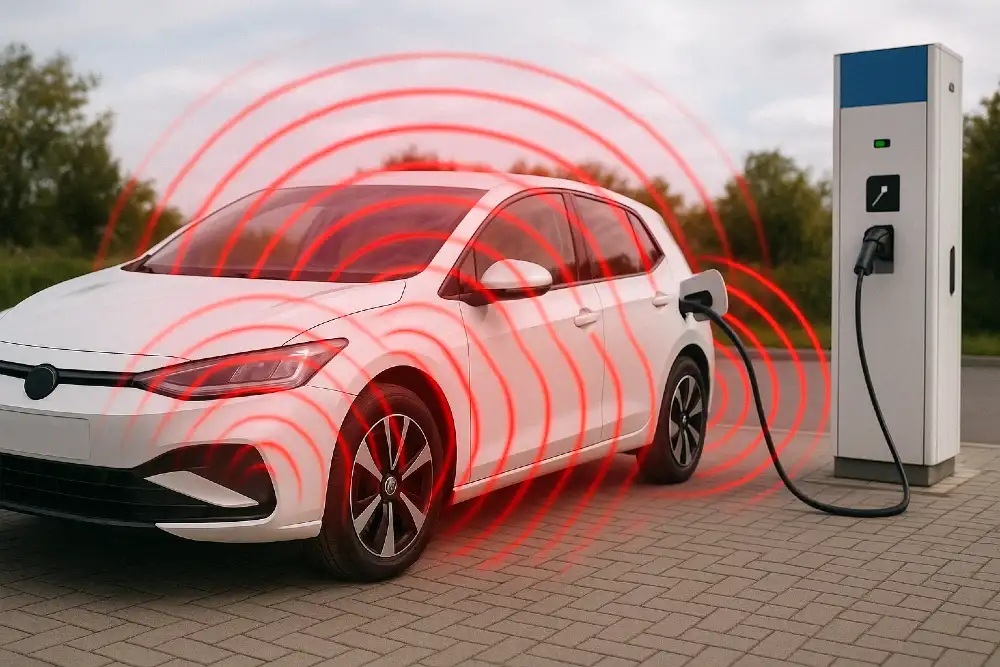What Type of Radiation Do Electric Vehicles Produce?

Electric vehicles (EVs) generate non-ionizing electromagnetic fields (EMFs) across multiple frequency bands as a byproduct of their powertrain and communication systems. These include:
- Static Magnetic Fields (SMF)
- Extremely Low Frequency (ELF) Magnetic Fields
- Radio Frequency (RF) Fields
Each of these is associated with distinct subsystems and operational states of the vehicle. The exposure profile is determined by component design, spatial layout, load conditions, and shielding effectiveness.
1. Static Magnetic Fields (SMF)
Static magnetic fields arise from direct current (DC) flow in components such as the battery system and DC charging circuits. The most significant levels occur during fast-charging events, when high DC currents are routed through cables and connectors.
Measured field strengths in proximity to these conductors can reach up to 0.2 millitesla (mT), particularly near underfloor battery wiring and charging inlets.
2. Extremely Low Frequency (ELF) Magnetic Fields
ELF magnetic fields are induced by alternating current (AC) present in various power electronics subsystems, including inverters, motor drives, and ancillary systems such as heated seats.
Field levels are typically observed in the 0.2–30 µT range, though localized peaks may occur based on component proximity and passenger seating position. Contributing sources include:
- AC cables routed through the chassis
- Traction inverters and motor windings
- DC-AC converters in auxiliary systems
- Heating elements integrated into cabin features
The ELF profile within the cabin is highly dependent on driving conditions, current flow intensity, and routing geometry of high-power conductors.
3. Radio Frequency (RF) Fields
Higher frequency EMFs in EVs originate from onboard wireless technologies operating in the megahertz (MHz) to gigahertz (GHz) range. These include:
- Cellular transceivers (3G/4G/5G)
- Vehicle-to-Everything (V2X) communications
- Bluetooth modules
- Wi-Fi routers
These emissions are concentrated around antenna locations and RF modules. Exposure is intermittent but can be increased in data-intensive scenarios or during signal handshake with external infrastructure such as cellular towers or roadside units (RSUs).
Non-Ionizing EM Radiation
It is important to distinguish that the EM radiation emitted by EV systems is non-ionizing. As such, it lacks the quantum energy to break molecular bonds or ionize biological tissue.
However, the biological effect of chronic exposure to low-frequency AC magnetic fields remains under active investigation. Notably, the International Agency for Research on Cancer (IARC) has categorized ELF magnetic fields as Group 2B “possibly carcinogenic to humans” based on epidemiological correlations with childhood leukemia.
Field intensity, spectral distribution, and spatial exposure gradients vary widely across vehicle models due to differences in architecture, shielding strategies, and component integration. While most emissions remain within limits defined by International Committee for Non-Ionizing Radiation Protection (ICNIRP), it’s important to note that ICNIRP guidelines are primarily designed for short-term exposure and do not set limits for continuous, chronic exposure, which are conditions that are far more relevant in the context of prolonged car use.
Certain scenarios, such as extended cabin occupancy near high-current paths or long-duration charging, may reach upper exposure thresholds. These require further scrutiny in both technical design and health risk assessments.

